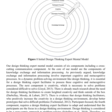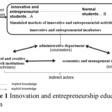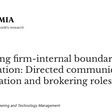This is an overview of some interesting open access papers published in the last two weeks!

Conventional wisdom is that entrepreneurship and innovation are closely related like siblings entangled with each other on a playground. Entrepreneurs are often said to be innovative, suggesting that entrepreneurs need to be innovative in order to succeed in their endeavor
|
|

This paper takes a deep dive into the academic literature to find different focus areas for the impact that Innovation & Entrepreneurship has on economic development.
|
|

This paper by Christopher Williams tries to find a conceptual model to help companies choose between the abundance of different agile innovation models when pursuing innovation. He developed a first version of the Design Thinking Mental Model.
|
|

Much in line with our findings in the games we offer at Innovative Dutch, this paper by Qu finds that bringing a competition element into innovation & entrepreneurship education broadens their vision on the subject matter.
|
|

This article provides a summary of the hottest topics in Innovation Management Research over the last decade or so. Great visualisation!
|
|

This paper by Ozan summarises trends in Open Innovation and identifies key aspects of future research areas within Open Innovation.
|
|

This case study into Indonesia village-owned enterprises shows that it does: “When the environmental management and green innovation increase, the competitive advantage [and firm performance] will also increase.”
|
|

Using simulated markets in innovation and education education helps knowledge flow between lecturers and students, that’s the claim of this paper.
|
|

This paper, chapter 26 of the book, finds that companies who initiate and manage a multi-stakeholder network for responsible innovation activities are better at both exploration and exploitation of innovation.
|
|

This paper by Dolfsma – with some author comments in Dutch still in the sideline  – is exploring the fact that internal boundaries between units/departments are often much harder to overcome then external boundaries. In other words: it’s easier to collaborate with other firms than with other business units.
|
|

This paper analysed how complex regional innovation systems work and what the different aspects of knowledge management and knowledge sharing within those systems are. Great and very useful visualisation!
|
|